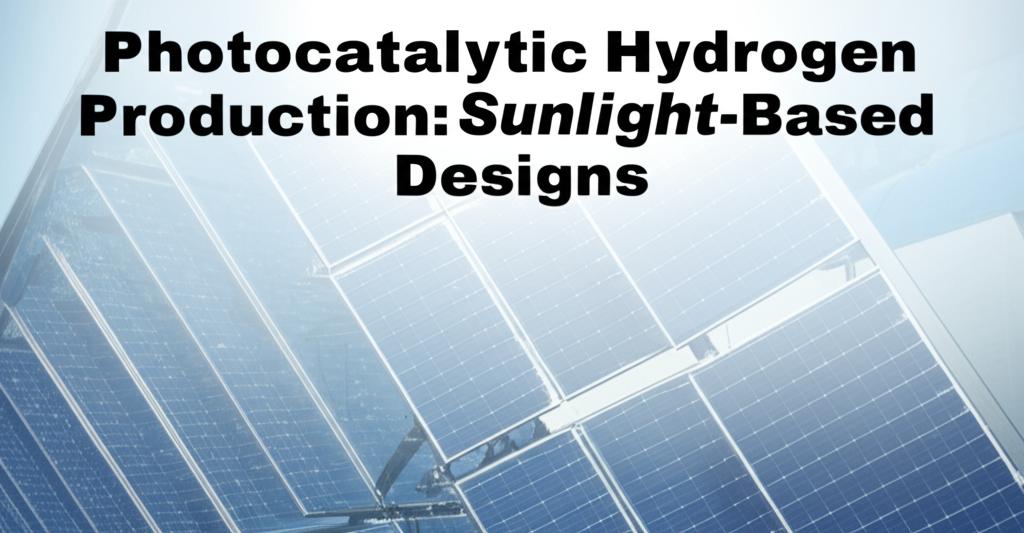Harnessing sunlight to split water into hydrogen and oxygen through photocatalysis is a cornerstone strategy for producing clean, renewable hydrogen fuel. This process, inspired by natural photosynthesis, uses semiconductor materials (photocatalysts) that absorb solar energy to drive the water-splitting reaction. The design of the photoreactor, the system housing the catalyst and facilitating the reaction under sunlight, is critical for maximizing efficiency, enabling scalability, and ensuring cost-effectiveness.
Fundamental Principles and Reactor NeedsThe core function of a photocatalytic reactor is to efficiently expose the photocatalyst material to sunlight while managing the reactants (water) and collecting the products (hydrogen and oxygen). Key challenges revolve around optimizing light absorption, minimizing energy losses from reflection or scattering, ensuring efficient mass transfer of reactants and products, and facilitating the separation of hydrogen and oxygen gases, which can form an explosive mixture if not handled correctly. Ideally, reactors should be cost-effective to build and operate, durable under outdoor conditions, and scalable for large-scale deployment.
Innovations in Sunlight-Based Reactor DesignsResearchers are exploring various reactor configurations to address these challenges:
- Panel and Sheet Reactors: A prominent approach involves immobilizing particulate photocatalysts onto sheets or panels. These can be arranged in large arrays, similar to solar photovoltaic panels. This design facilitates scalability and avoids issues associated with stirring catalyst powders (slurries) in large tanks, such as light blockage and particle recovery. Recent demonstrations include large-scale (e.g., 100 m²) outdoor prototype panel reactors using photocatalyst sheets, providing crucial data on real-world performance and long-term stability under natural sunlight. Some designs focus on cost-effective manufacturing using techniques like polymer extrusion.
- Floating Photocatalytic Reactors: These reactors are designed to float on water bodies, maximizing sunlight exposure and potentially reducing land-use requirements. They often combine lightweight, buoyant materials with photoactive coatings. This concept is particularly appealing for integrating hydrogen production directly with water sources.
- Photocatalytic Membrane Reactors (PMRs): PMRs integrate photocatalysis with membrane separation technology. A semipermeable membrane separates the reaction zone from the product collection zone, allowing selective passage of hydrogen gas. This enhances product purity, simplifies separation, and can improve overall process efficiency.
- Loop Reactors: These reactors utilize internal circulation, often via a draft tube, to ensure excellent mixing and high mass transfer rates between the catalyst, water, and evolving gas bubbles. Their relatively simple design and potentially low operational costs make them a candidate for scaling up photocatalytic processes.
- Concentrated Solar Power (CSP) Integration: Some designs explore using concentrating solar technologies to increase the intensity of sunlight reaching the photocatalyst. While potentially boosting reaction rates, this approach requires careful thermal management and robust catalyst materials capable of handling higher light intensities and temperatures.
- Advanced Light Harvesting Designs: Innovations include reactors designed to capture photons efficiently regardless of the sun's angle, potentially eliminating the need for expensive and complex sun-tracking mechanisms. This often involves specific geometries or optical features within the reactor structure.
While laboratory experiments have shown promising solar-to-hydrogen (STH) conversion efficiencies (sometimes exceeding 2-3%), achieving high efficiencies in large-scale, outdoor systems remains a significant hurdle. Demonstrated efficiencies in scaled-up prototypes under natural sunlight are often lower, though sometimes performance under real sunlight (with more UV/short-wavelength components) can exceed that under simulated standard sunlight.
A key target for practical implementation often cited is achieving STH efficiencies above 5-10%, sustained over long operational periods (months to years) to be economically competitive. Current research intensely focuses on developing more efficient and stable photocatalysts that can utilize a broader spectrum of sunlight (especially visible light) and designing reactors that maximize the performance of these catalysts under real-world conditions. Safety, particularly the management or separate evolution of hydrogen and oxygen, is also a critical design consideration.
Future DirectionsThe path forward involves a synergistic approach combining materials science (developing better catalysts) and engineering (designing optimized, scalable, and cost-effective reactors). Ongoing efforts include testing larger prototypes, standardizing efficiency measurement protocols, establishing safety regulations, and exploring novel materials and reactor concepts to bridge the gap between laboratory potential and practical, large-scale solar hydrogen generation.

